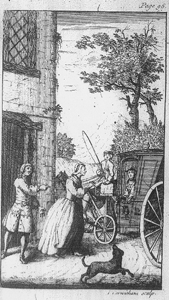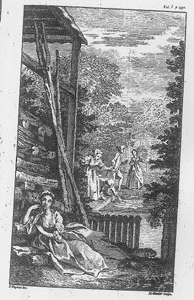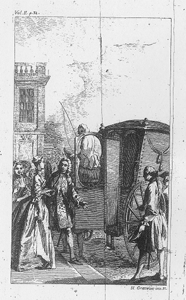![]()
Information about the percentage of illustrated books in the total book production in 18th-century England is not readily available, and numbers range from one-sixth to one third. The lower percentage refers to the term understood narrowly as the illustrations of the text, not including book decorations, single frontispieces, or series of prints with captions meant to be issued in book form. In the only report about surveys of this sort we found, only about ten percent of the books considered contained (relief) woodcuts. The rest were illustrated by various forms of (intaglio) copper plates, like line engravings, and new forms like aquatints, soft ground etching and stipples. However, these surveys did not pay much attention to popular literature and children's books of the period. Such books may have existed in much larger proportion than we now realize, since they were usually thrown away or destroyed by excessive use. Although most of them were illustrated, it was mainly with woodcuts, and in this regard, Pamela is again an exceptional example of exceptional expense incurred for a mass-produced book.

An Illustration from the 1741 Edition of Pamela
Much like in the other fields of activity that involved mercantile interest, England in the eighteenth century interacted with other European countries exchanging influences in the fields of culture and art. Much of the older literature on English book illustration used for this research project shows ambivalence about the scale of impact that French printing and engraving in particular exacted on the English book culture and artistic taste in the period. Even within the same study, Norma Levarie claims that "in all things, French taste dominated the century," and that "England, unlike other European countries, remained independent of France" can be found, indicating the importance of books and their aesthetics as a mirror of English cultural and political power.
The French print culture, mainly because of the social stratification that differed so dramatically from the English one (the Bourgeois Revolution of 1789 only escalating the class tensions), allowed a small group of the immensely wealthy to perform expensive experiments on their private presses. The French court, enamored of the arts, conceived a particular passion for the illustrating, and even the printing of their own editions. Louis XV was a printing enthusiast. He, his brother, the Duke of Burgundy, and his mother all had private presses. Madame de Pompadour, Louis's mistress, engraved illustrations to Corneille's Rodogune. The professional printers associated with the court, the Imprimerie Royale, dictated the taste that was later imitated by other private presses, particularly in the matters of lighter, gayer Rococo taste, which favored production of smaller books, reduced enough in size to be held in the hand.
Pamela was a typical English product of the shift from the seventeenth-century book production, where the output of print shops had constituted mainly of religious literature, to the eighteenth century, and an enormous surge in the volume of printed matter. The cost of printing was on a decline, and the kinds of reading material offered to the general public reflected sensitivity to the desires of the new kind of customers, economically situated in the middle class. (Note 2 Levarie Art and History of Books) The shifting social structure of eighteenth-century England dictated that the exclusive lavishness (and occasional frivolity) of French bookmaking art could not be easily replicated for the purposes of appealing to a widening, and frequently puritanical, bourgeois reading public in England. However, several French artists and engravers, including Gravelot, a book illustrator who lived in England for over a decade, had noticeable impact on the quality and taste of English engraving. Gravelot's work was commissioned by Richardson for one of the editions of Pamela we are featuring on this site.

An illustration from the 1742 edition of Pamela, illustrated by Gravelot
As the eighteenth century began, English book illustration in general was strongly influenced by Dutch and French classicism and the resident foreign artists and artisans (the designer and the engraver of a work in this period are not necessarily the same, although it is not always possible to determine the identities of both because the designer's name was frequently omitted from the credits). The largest grouping of these artists were Dutch, some of whom had come over with William of Orange in 1688. A great number, however, were French Huguenots, driven from France by the Revocation of the Edict of Nantes in 1685. According to the surveys mentioned above, about three-quarters of the designers and engravers whose work is found in English books before 1730 were Continental Europeans, newly, or only temporarily resident at that time in the British Isles. As the century advanced and many of the artists became naturalized, this proportion changed rapidly. About 1780 the proportion was probably nearly in reverse, and English art came into worldwide fashion during the last two decades of the eighteenth century. Whereas in 1660 England had only one prominent native book illustrator (Francis Barlow), and in 1730 only a few (of whom William Hogarth was the most influential one), fifty odd years later there were more than half a dozen, including William Blake, Thomas Bewick, John Flaxman, and Thomas Rowlandson.
Gravelot, illustrator of the luxury edition of Pamela, is frequently mentioned as a particularly influential French artist in England at the time. He was resident in the country from 1732 to 1745, working as a book illustrator and ornamental designer. Gravelot also taught at the academy in St. Martin's Lane in London, and continued to supply illustrations to English publishers until afterl after 1750. Gravelot's illustrations always featured sophisticated decor and dress, the elements which later influenced the work of English artists and their taste for elegant illustration. Aside from the illustrations for Pamela, Gravelot's most appreciated work appears in an edition of Gay's Fables.

Gravelot's illustration for the 1742 edition of Pamela
Interestingly enough, William Hogarth, the most prominent English engraver and book illustrator of the century, never got to provide illustrations for Pamela, although he was in enormous demand with other novelists, like Sterne and Smollett. One possible reason for Hogarth's absence from Richardson's texts might be that the pervasive intent of edification incorporated into Pamela would have been greatly undermined by Hogarth's general taste for irony and satire. Hogarth gave a great push not only to book illustration, but to the print-making industry in general, by his emphasis on engraving and by his securing an act of Parliament in 1735 which essentially protected the copyright of an artist's own designs for a period of fourteen years. Hogarth usually executed his own drawings on copper plates, an effort many of the celebrated painters in the succeeding generations felt to be beneath their dignity or requiring too great an expenditure of time.
Throughout the
last half of the eighteenth century, artists and artisans from other visually-oriented
fields worked on book illustration. Architects like William Chambers, landscape
gardeners like Humphrey Repton, and cabinet makers like Thomas Chippendale were
increasingly active in committing their new concepts to books. English archaeologists,
explorers, travelers, natural historians, and antiquarians also used the technology
to display their findings in book format.
![]()
Sources: Eighteenth-Century Book Illustration; David Bland, , A History of Book Illustration; Norma Levarie, The Art and History of Books